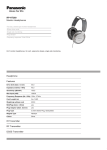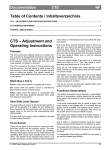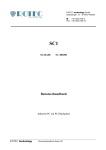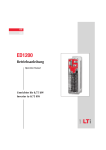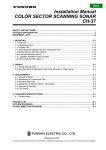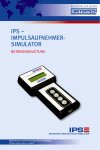Download Table of Contents / Inhaltsverzeichnis GSF2 œ Operating Instructions
Transcript
Documentation GSF2 Table of Contents / Inhaltsverzeichnis GSF2 – OPERATING INSTRUCTIONS.......................................................................................................................1 GSF2 - GEBRAUCHSHINWEISE ................................................................................................................................3 GSF2 – Operating Instructions General For optimized acceleration it is important to shift gears always at the right engine speed, that means a precise timing for changing gears is necessary. Normally a driver shifts into the next gear, as soon as the acceleration decreases recognizable. However this is in most cases too late, and the engine is unnecessarily loaded with high engine speed. As a race pilot has to concentrate mainly on the course and therefore he should avoid watching the engine speed display, we have designed an indicator unit, that can be easily noticed, even if the driver watches the racing track only. A short flash light invites the driver to change gears. This flash is easily recognizable even under sunlight conditions. We have tested several engine speed metres and found out considerable deviations from the real engine speed. Nearly all engine speed metres of bikes in the Super-Sport range (Japanese 4 stroke motor bikes, 600 ccm to 750 ccm) display a positive static speed offset of about 1,000 rpm to 2,000 rpm. Also the speed metres of factory bikes have been tested, and their speed display showed likewise deviations from the real engine speed: • • • static deviation at 10,000 rpm to 13,000 rpm: 100 rpm to 400 rpm delay due to damping: about 0.2 sec absolute error during an engine speed rise of 3,000 rpm/sec: -600 rpm These results show, that the standard motor speed display can be used for optimized gear shifting only in the maximum speed range of the vehicle, i.e. only during small speed variations. This is the reason why in may types of racing sports, drivers dispense with the support of an engine speed display, (e.g. MotoCross, Go-Kart, Enduro), although an assisting device would be very useful. Engine Speed Signal Due to the fact, that no standardised engine speed signal is available for all vehicles, several variations of the GSF2 have been prepared. The type name of a GSF2 box consists of a letter sequence which indicates the engine speed signal source, and a type © 2000 Tellert Elektronik GmbH number which specifies the crankshaft angle per engine speed pulse. Letter sequen ce TR CDI D HT Description Transistor ignition Condenser discharge ignition Engine speed signal directly from electronical engine speed metre High tension (engine speed signal from ignition wire via a capacitive coupling) Type Description number 120 Three ignitions per crankshaft revolution. 180 Two ignitions per crankshaft revolution. This concerns two-stroke engines (one or two cylinders) with a 180° ignition shift, where the ignition wires may be swapped. 360 One ignition per crankshaft revolution. This concerns two-stroke engines. This is the most usual type of ignition for two-stroke (one cylinder) engines and for four-stroke engines (1-/4-cylinder and boxers). 720 One ignition per two crankshaft revolutions. This concerns 4-stroke engines, where the ignition is controlled by the camshaft. Best results are achieved with the TR- and CDI-types, and therefore, the HT-type should only then be used if the TR- or CDI-type is not possible. GSF2-TR120, GSF2-TR180, GSF2-TR360, GSF2TR720: These models can be used in vehicles with transistor ignition (battery ignition). The engine speed signal is received by connecting the GSF2 box directly to the connection point of ignition coil and black box (German Standard: Pin 1 of ignition coil). The three wires of the electronic box have to be connected as follows: Wire Red Brown Black Plug Pin 1 Pin 2 Pin 3 Description 12 V supply voltage (plus pole) Ground (minus pole) Signal from ignition coil GSF2-CDI120, GSF2-CDI180, GSF2-CDI360, GSF2CDI720: These models can be used in vehicles with condenser discharge ignition. The engine speed signal is received by connecting the GSF2 box directly to the connection point of ignition coil and black box. In most cases, also the signal from the engine speed metre can be used instead. The three wires of the electronic box have to be connected as follows: 1/4 Documentation Wire Red Brown Black Plug Pin 1 Pin 2 Pin 3 GSF2 Description 12 V supply voltage (plus pole) Ground (minus pole) Signal from ignition coil GSF2-D120, GSF2-D180, GSF2-D360, GSF2-D720: These models can be used in vehicles with those electronical engine speed metres, which take the engine speed signal from the black box and not from the ignition coil. The three wires of the electronic box have to be connected as follows: Wire Red Brown Black Plug Pin 1 Pin 2 Pin 3 Description 12 V supply voltage (plus pole) Ground (minus pole) Signal from engine speed metre GSF2-HT180, GSF2-HT360, GSF2-HT720: The two wires of the GSF2 have to be connected as follows: Wire Black Brown Plug Pin 1 Pin 2 Description 12 V supply voltage (plus pole) Ground (minus pole) The black wire of the GSF2 box is used as an antenna for signal reception of the engine speed signal. For that reason the end of this solid wire must be twisted one time around the ignition cable (approximately in the middle of this cable). It should be taken care, that no electrical connection between the high voltage ignition cable and the antenna wire will be established. Additionally it should be paid attention, that this location could not get wet during rain. Technical Data Supply voltage: Standby current: Speed limit setup: 8 V … 15 V about 30 mA 6,000 rpm … 15,900 rpm in steps of 100 rpm Modes: continuous light, single flash, double flash Size of elect. module: 72 mm × 50 mm × 22 mm Mass: 100 grams Modes of Operation Permanent Mode: As long as the engine speed exceeds the predefined level, the halogen lamp of the GSF2 unit is lighted. Normally this happens only for a short period, if the driver accepts the advice to change gears and the engine speed will drop. A disadvantage of this mode is the permanent light if you are already driving in the highest gear and a speed reduction is not possible, for instance due to tail wind. Single Mode: The light flashes only for a short pulse of 0.3 seconds, as soon as the engine speed limit is exceeded. This avoids the disadvantage of the Permanent Mode. Dual Mode: Especially for training support, an additional second flash of light will be radiated after a delay of 0.3 seconds if the engine speed is still above © 2000 Tellert Elektronik GmbH the set trigger level. When the driver is able to shift within that time period, the second flash will be suppressed. Setup of Engine Speed Limit When you open the top of the GSF2-module, a short instruction sketch for adjustment of the speed limit is visible at the inner side of the top cover. The engine speed trigger level can be set via two rotary switches when the top cover has been removed. The left switch is used for setting the multiples of 1,000 rpm (according to following table), and the right switch for the additional multiples of 100 rpm. Left rotary switch 0 1 2 3 4 5 6 7 8 9 Engine speed [rpm] 10,000 11,000 12,000 13,000 14,000 15,000 6,000 7,000 8,000 9,000 Three examples will illustrate the speed setup procedure: Desired engine speed [rpm] 7,900 10,000 13,200 Left rotary switch 7 0 3 Right rotary switch 9 0 2 Setup of Operating Mode When you open the cover of the electronic module a line of jumpers with four possible positions is visible. Test Mode (Jumper position 1 from top): Setting the jumper to the top position enables the test mode. In the test mode, the halogen lamp will always be supplied with current, and therefore, the lamp will always light. This mode can be used to test the lamp and to adjust its position. Permanent Mode (Jumper position 2 from top): In the permanent mode, the lamp will light as long as the engine speed is over the set value. Single Mode (Jumper position 3 from top): In the single mode, the lamp will flash for a period of maximal 0.3 seconds if the engine speed is over the set value. An engine speed below this value will stop the lighting instantly. Dual Mode (jumper position 4 from top): In the dual mode, the lamp will flash two times (in a distance of 0.3 seconds) if the engine speed is over the set value. An engine speed below this value will stop the 2/4 Documentation GSF2 lightning instantly, and omit the second flash if possible. GSF2 - Gebrauchshinweise Buchstabenfolge TR CDI D Allgemeines HT Für optimale Beschleunigungen ist es wichtig, im richtigen Moment hochzuschalten. Meistens schaltet der Fahrer erst dann, wenn die Beschleunigung spürbar nachläßt. Dies ist jedoch in der Regel zu spät, und belastet mit unnötig hohen Drehzahlen den Motor. Da sich der Fahrer auf die Rennstrecke konzentrieren muß und ständiges Kontrollieren des Drehzahlmessers vermeiden soll, haben wir eine GangwechselAnzeige entwickelt, die auch dann wahrgenommen wird, wenn man sich ausschließlich auf die Streckenführung konzentriert: Ein kurzes Blitzsignal fordert den Fahrer zum Gangwechsel auf. Dieser Blitz ist auch bei Sonnenschein deutlich zu sehen. Wir haben verschiedene Drehzahlmesser getestet und dabei erhebliche Abweichungen von der tatsächlichen Drehzahl festgestellt. Nahezu alle Drehzahlmesser aus dem „Supersport“-Bereich (japanische Viertakt-Motorräder, 600 ccm bis 750 ccm) weisen eine statische Voreilung von -1 -1 1.000 min bis 2.000 min auf. Auch die Drehzahlmesser von Werksmaschinen wurden von uns getestet, und wiesen ebenfalls Abweichungen von der Ist-Drehzahl auf: -1 • statische Abweichung bei 10.000 min -1 -1 -1 bis 13.000 min : 100 min bis 400 min • Dämpfung (Verzögerung): ca. 0,2 s • absoluter Fehler bei einem Drehzahlanstieg von -1 -1 3.000 min /sec: −600 min Aus diesen Ergebnissen resultiert, daß ein Drehzahlmesser nur in der Nähe der Höchstgeschwindigkeit des Fahrzeugs (d.h. geringer Drehzahlanstieg und Drehzahlabfall) zum optimalen Schalten verwendet werden kann. Darum wird in vielen Rennsportarten auf einen Drehzahlmesser als Schalthilfe verzichtet (z.B. beim Moto-Cross, Go-Kart, Enduro), obwohl auch hier eine Hilfe zum optimalen Schalten sehr nützlich wäre. Drehzahlsignal Da kein einheitliches Drehzahlsignal für alle Motorräder vorhanden ist, gibt es verschiedene Ausführungen von GSF2. Der Typname einer GSF2-Box besteht aus einer Buchstabenfolge, welche die Quelle des Drehzahlsignals angibt, und aus einer Nummer welche das Verhältnis von Kurbelwellendrehung pro Drehzahlpuls festlegt. © 2000 Tellert Elektronik GmbH Typennummer 120 180 360 720 Beschreibung Transistorzündung Kondensatorzündung Drehzahlsignal direkt vom elektronischen Drehzahlmesser Drehzahlsignal über kapazitive Kopplung vom Zündungskabel Beschreibung Drei Drehzahlpulse pro Kurbelwellenumdrehung Zwei Drehzahlpulse pro Kurbelwellenumdrehung. Dies betrifft Einzylinder-Zweitakter oder Zweizylinder-Zweitakter mit 180°Zündversatz, bei denen die Zündkabel vertauscht werden dürfen. Ein Drehzahlpuls pro Kurbelwellenumdrehung. Dies ist die gängigste Zündfolge für Zweitakter (Einzylinder) und Viertakter (Einzylinder, Vierzylinder, Boxer). Ein Drehzahlpuls pro zwei Kurbelwellenumdrehungen. Dies betrifft Viertakter, deren Zündanlage von der Nockenwelle gesteuert wird. GSF2-TR120, GSF2-TR180, GSF2-TR360, GSF2TR720: Ausführung für Fahrzeuge mit Transistorzündung (Batteriezündung). Das Drehzahlsignal wird direkt von dem Verbindungspunkt von Zündspule und Blackbox genommen (Deutsche Norm: Klemme 1 der Zündspule). Die Elektronikbox besitzt drei Anschlußkabel, wobei die Kabel wie folgt belegt sind: Leitung rot braun schwarz Stecker Pin 1 Pin 2 Pin 3 Belegung 12 V (Pluspol) Masse (Minuspol) Signal von der Zündspule GSF2-CDI120, GSF2-CDI180, GSF2-CDI360, GSF2CDI720: Ausführung für Fahrzeuge mit Kondensatorzündung. Das Drehzahlsignal wird direkt von dem Verbindungspunkt von Zündspule und Blackbox genommen. In den meisten Fällen eignet sich auch das Drehzahlmesser-Signal. Die Elektronikbox besitzt drei Anschlußkabel, wobei die Kabel wie folgt belegt sind: Leitung rot braun schwarz Stecker Pin 1 Pin 2 Pin 3 Belegung 12 V (Pluspol) Masse (Minuspol) Signal von der Zündspule GSF2-D120, GSF2-D180, GSF2-D360, GSF2-D720: Ausführung für Fahrzeuge mit elektronischem Drehzahlmesser. Der Drehzahlmesser muss das Drehzahlsignal der Blackbox verwenden und darf 3/4 Documentation GSF2 nicht direkt an der Zündspule angeschlossen sein. Die Elektronikbox besitzt drei Anschlusskabel, wobei die Kabel wie folgt belegt sind: Leitung rot braun schwarz Stecker Pin 1 Pin 2 Pin 3 Belegung 12 V (Pluspol) Masse (Minuspol) Signal vom Drehzahlmesser GSF2-HT180, GSF2-HT180, GSF2-HT180: Die Elektronikbox besitzt zwei Anschlußleitungen für die Stromversorgung: Leitung schwarz braun Stecker Pin 1 Pin 2 Belegung 12 V (Pluspol) Masse (Minuspol) Die schwarze Leitung der Elektronikbox empfängt die Drehzahlsignale und wird als Antenne betrieben. Dazu muß bei einer Kondensatorzündung das Ende dieses Antennenkabels um das Zündkabel einmal umwickelt werden. Es darf keine elektrische Verbindung zwischen dem Hochspannungskabel der Zündung und der schwarzen Leitung der GSF2-Box entstehen. Ebenso ist zu beachten, daß die Wicklungsstelle und das Antennenende bei Regen nicht naß werden dürfen. Technische Daten Versorgung: Ruhestrom: Drehzahleinstellung: Modi: Maße der ElektronikBox: Gewicht: 8 V bis 15 V ca. 30 mA -1 -1 6.000 min bis 15.900 min -1 in 100 min -Schritten Dauerlicht, Einzelblitz, Doppelblitz 72 mm × 50 mm × 22 mm 100 Gramm Betriebsarten Einfacher Modus: Solange die Drehzahl über der eingestellten Schwelle liegt, leuchtet die Lampe. Nachteilig ist, daß die Lampe dauernd leuchtet, wenn man bereits im höchsten Gang ist und durch Windschatten bzw. Rückenwind eine Verringerung der Drehzahl nicht möglich ist. Zeitbegrenzter Modus: Der zeitbegrenzte Modus umgeht den Nachteil des einfachen Modus, da nach 0,3 Sekunden die Lampe, unabhängig von der aktuellen Drehzahl, abgeschaltet wird. Dual-Modus: Im Dual-Modus wird (als Trainingshilfe) 0,3 Sekunden nach dem ersten Blitz ein zweiter ausgegeben, falls die Drehzahl noch immer über der eingestellten Schwelle liegt. Schaltet der Fahrer innerhalb von 0,3 Sekunden nach Aufforderung, so wird der zweite Blitz nicht ausgelöst (Standard-Einstellung). © 2000 Tellert Elektronik GmbH Einstellen der Drehzahl Eine Anleitungsskizze zum Einstellen der Drehzahl befindet sich auf der Innenseite des GSF2-BoxDeckels. Die Drehzahl wird nach dem Öffnen des Deckels über zwei Drehschalter eingestellt, wobei der linke Drehschalter die „Tausender“-Stelle (entsprechend folgender Tabelle) und der rechte Drehschalter die „Hunderter“-Stelle der Drehzahl festlegt : Linker Drehschalter 0 1 2 3 4 5 6 7 8 9 Drehzahl in min 10.000 11.000 12.000 13.000 14.000 15.000 6.000 7.000 8.000 9.000 -1 Die folgende Tabelle enthält drei Beispiele für das einstellen der Drehzahl: Gewünschte -1 Drehzahl [min ] 7.900 10.000 13.200 Linker Drehschalter 7 0 3 Rechter Drehschalter 9 0 2 Einstellen der Betriebsart Öffnet man den Deckel der Box, so ist eine Jumperleiste mit vier Jumperpositionen zu sehen. Setzt man den Jumper auf die oberste Position, so wird die Lampe mit Dauerstrom versorgt. Diese Betriebsart dient als Lampentest und zum optimalen Ausrichten der Lampe auf die Augen des Fahrers. Befindet sich der Jumper in der zweiten Position von oben brennt die Lampe, solange die eingestellte Drehzahl überschritten ist. Setzt man den Jumper auf die dritte Position von oben, dann blitzt die Lampe bei Erreichen der eingestellten Drehzahl einmal für maximal 0,3 Sekunden. Kommt man hierbei während den 0,3 Sekunden mit der Drehzahl unterhalb des Schwellenwertes, so wird das Blitzlicht sofort ausgeschaltet. Die unterste Position löst bei der gewählten Drehzahl zwei Blitze im Abstand von 0,3 Sekunden aus (Standardeinstellung). Auch hier wird das Blitzlicht (und auch der Folgeblitz) sofort ausgeschaltet, falls man innerhalb der 0,3 Sekunden unterhalb der eingestellten Drehzahl kommt. 4/4




